|
| What the Heck Does the Richmond Mayor Do?
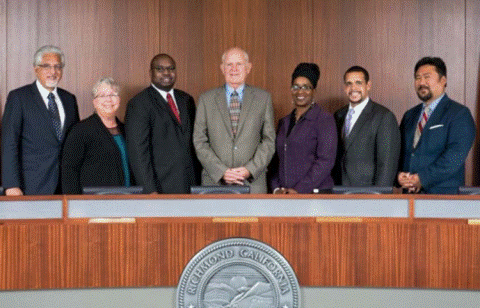
Figure 1 - 2017 Richmond City Council
Introduction
A lot of people don’t know what the mayor does or even what the mayor can do. Many think the position is like a czar (“You’re the mayor, aren’t you; make it happen!”). Many people who want to develop a project in Richmond or want to sell an idea or a product to the City think the mayor is where you start. Lots of people just have a complaints, usually about streets, potholes, weeds, trash, junk cars, squatters, barking dogs or roosters, and the mayor’s office is easy to find and always accessible – physically, by phone or by email. We also provide a Community Resource Guide to help people find the department or service they need.
After over two years, even I am still learning what the mayor does, could do and should do. I hope this sheds a little light for those who are interested enough to read it.
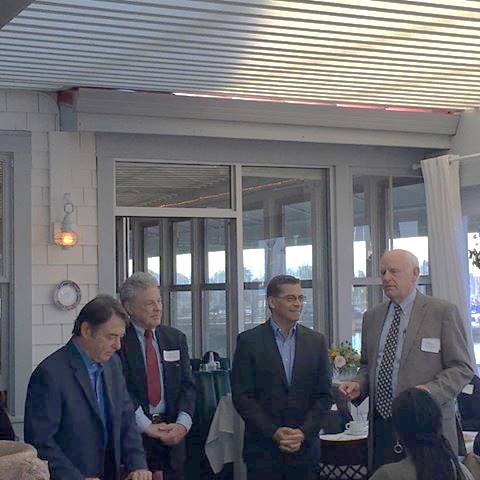
Figure 2 - Meeting with California Attorney general Xavier Becerra
The Richmond Mayor
Many larger cities in California, such as Oakland and San Francisco (which is also a county), have what is known as a strong mayor form of mayor-council government, in which the mayor is the administrator of the city with full executive authority.
Most smaller cities in California are “general law” cities that operate under a state law template for a council-manager form of government that includes five councilmembers who legislate and a city manager who administers. Most general law cities rotate the mayor annually among members. The mayor of a general law city is essentially a ceremonial position that includes presiding over city council meetings.
In a charter city, a mayor may be separately elected by the voters or selected by the city council from among its members. Many charter cities, including Richmond, have elected mayors who are expected to provide a higher level of civic political leadership than those of general law cities.
Before 1980, the mayor of Richmond was selected by vote of City Council members annually from one of their own on a rotating basis, sometimes tinged by politics but other times simply by a rule of thumb that the senior City Council member who had not served for the longest period would rotate in.
In 1980, by Charter amendment, the voters of Richmond decided to have an elected mayor who would serve a four-year term and be limited to two terms.
The pros and cons of the Richmond charter amendment of 1980 that created an elected mayor are lost in time, but presumably the advocates wanted a higher profile, more visible and enduring level of civic leadership, with an emphasis on policy advocacy.
Tom Corcoran was the first elected Richmond mayor. He died in office in 1985, and Vice-Mayor Mayor George Livingston assumed office.
In 1989, George Livingston was elected to a full term but was defeated by Rosemary Corbin in 1993. Corbin served two full terms and was replaced by Irma Anderson, elected in 2000, as the mayor and City Council terms shifted to even years to match the state and national general elections.
Irma Anderson served a single term and as was defeated by Gayle McLaughlin in 2004. McLaughlin served two full terms until I was elected in 2014, becoming Richmond’s sixth elected mayor, taking office in January 2015.
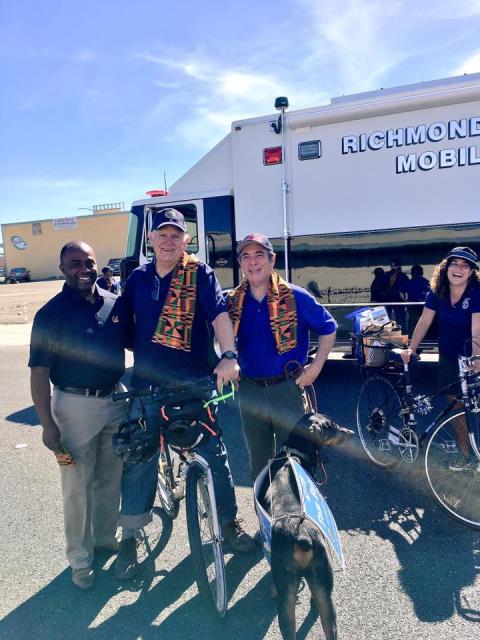
Figure 3 - At 2017 Juneteenth parade with Assembly member Tony Thurmond and Supervisor John Gioia
The job description of the mayor of Richmond is not well defined, but what definition there is can be found in Article III-A of the Charter, copied below:
ARTICLE III-A
(added at election November 4, 1980)
The Mayor
Sec. 1. Elected Mayor. There shall be a Mayor of the City of Richmond who shall have the powers and duties and shall be elected by the voters in the manner set forth herein.
Sec. 2. Powers and Duties of the Mayor. The Mayor shall be a member of the City Council and shall have all of the powers and duties of a member of the Council unless otherwise specified herein. In addition, the Mayor shall have the following powers and duties:
(a) Political Position. The Mayor shall be the chief elected officer and ceremonial head of the City, responsible for providing civic leadership and taking issues to the people, and marshalling public interest in and support for municipal activity. The Mayor shall be concerned with the general development of the community and the general level of City services and activity programs and may develop and inform City residents of policies and programs which he or she believes are necessary for the welfare of the City.
(b) Policy, Program and Budget. The Mayor may make recommendations to the City Council on matters of policy and program which require Council decision and may propose ordinances and resolutions for Council consideration. The Mayor shall work with the City Manager in preparing an annual budget for submission to the City Council. The Mayor shall make an annual report to the City Council as to the conditions and affairs of the City.
(c) (As amended at election November 6, 1984 and November 2, 2004) Appointments and Removals. The Mayor shall have the authority at any regularly scheduled meeting of the City Council to make appointments to or removals from all City boards, commissions and committees with the concurrence of at least four (4) other members of the City Council. (Added at the election November 2, 2004)Effective with the November 2008 election, the Mayor shall have the authority at any regularly scheduled meeting of the City Council to make appointments to or removals from all City boards, commissions and committees with the concurrence of at least three (3) other members of the City Council.
(d) Relationship with City Council. The Mayor shall be a voting member of and preside over meetings of the City Council. The Mayor shall annually appoint standing committees of the City Council; provided that the Mayor shall not be a member of such committees. Reports of the standing committees shall be made at regular City Council meetings or whenever the Mayor shall so require(e) (As amended at election November 2, 2004)
Continuance Authority. The Mayor shall have the authority to continue any item being considered by the City Council at a Council meeting for up to two weeks. The Council may override an action taken by the Mayor to continue an item by the affirmative vote of five (5) members of the Council. (Added at the election November 2, 2004)Effective with the November 2008 election, the Mayor shall have the authority to continue any item being considered by the City Council at a Council meeting for up to two weeks. The Council may override an action taken by the Mayor to continue an item by the affirmative vote of four members of the Council.
(f) Administrative Responsibility. The Mayor shall sign all contracts on behalf of the City which are acted upon and approved by the City Council unless otherwise delegated by the City Council to a City official or employee, and shall exercise such other powers and duties as provided in this charter and ordinances and resolutions of the City.
The specific jobs of the mayor required by the Charter include:
- State of the City report (“The Mayor shall make an annual report to the City Council as to the conditions and affairs of the City.”)
- Board and Commission Appointments (“The Mayor shall have the authority at any regularly scheduled meeting of the City Council to make appointments to or removals from all City boards, commissions and committees with the concurrence of at least four (4) other members of the City Council.”)
- Budgets (“The Mayor shall work with the City Manager in preparing an annual budget for submission to the City Council.”) See Adopted FY2017-2018 Operating Budget.
- Preside at City Council Meetings (“The Mayor shall be a voting member of and preside over meetings of the City Council.”)
- Contracts (“The Mayor shall sign all contracts on behalf of the City which are acted upon and approved by the City Council unless otherwise delegated by the City Council to a City official or employee, and shall exercise such other powers and duties as provided in this charter and ordinances and resolutions of the City.”)
Less well defined are the following additional responsibilities and opportunities:
Political Position. (“Political Position. The Mayor shall be the chief elected officer and ceremonial head of the City, responsible for providing civic leadership and taking issues to the people, and marshalling public interest in and support for municipal activity. The Mayor shall be concerned with the general development of the community and the general level of City services and activity programs and may develop and inform City residents of policies and programs which he or she believes are necessary for the welfare of the City.”
That is a pretty broad assignment to be backed by no power except a single vote on the City Council!
The term “political position” can be interpreted many ways, including simply “relating to the government or the public affairs of a country.” Or it can be broader, such as “relating to the ideas or strategies of a particular party or group in politics.” I believe the intent of the Charter includes the latter, where the mayor is expected, or at least permitted, to use the office as a platform for personal political advocacy, rather than simply a representation of the policies held by a City Council majority.
The Charter clearly intends for the mayor to have an advocacy role and not just a ceremonial role.
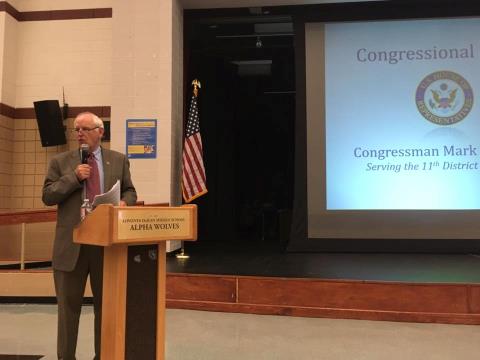
Figure 4 - Introducing Congressman DeSaulnier at Richmond Town Hall
The mayor’s annual salary is $45,500 plus the same health benefits that other City employees receive as well as mandatory workers compensation and unemployment insurance. The mayor does not receive a pension.
The Mayor’s Staff
There is no provision for a staff to support the mayor in either the Charter or in the Richmond Municipal Code. Neither the number of Mayor’s Office staff members nor the budget for the office is specified anywhere. Both must be determined by the budget set by the City Council. Staffing and budget have evolved over the years to the current level. Currently, the Mayor’s Office has four staff members:
- Alex Knox – Chief of Staff
- Sequoia Erasmus – Director of Community Engagement
- Christopher Whitmore – Director of Policy and Strategy
- Irene Perdomo - Director of Projects and Programs
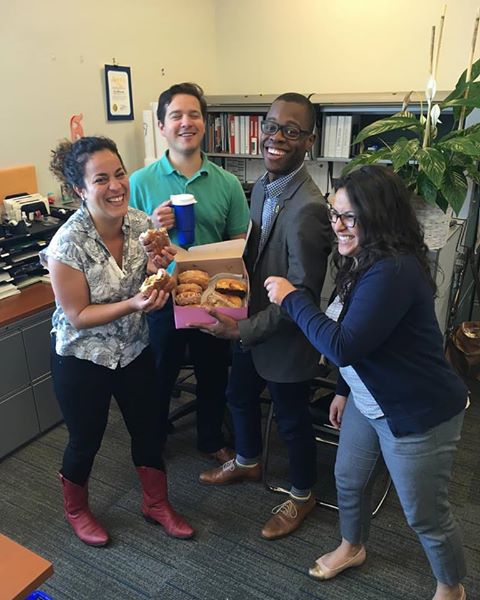
Figure 5 - The mayor's staff - Sequoia Erasmus, Alex Knox, Christopher Whitmore and Irene Perdomo
The mayor’s staff work really hard. They are regularly at City at events night and weekend. I meet with my four staff members each week to review progress on programs and projects and plan activities for the week ahead. A typical staff meeting agenda and report is at the end of this email.
The Mayor’s Priorities
My broad priorities as mayor broad priorities have not changed since they were first articulated in the State of the City presentation in 2015, and include:
- Business, Jobs and Economic Development
- Environment and Sustainability
- Equity and Quality of Life
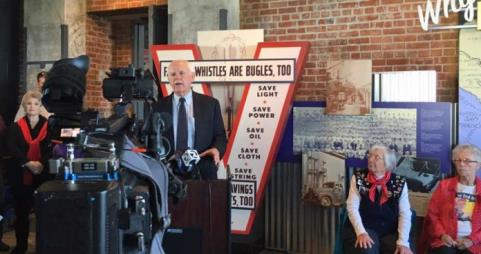
Figure 6 – Rosie the Riveter day at Rosie the Riveter Visitor Center
Strategic Priorities
My broad priorities were established in the State of the City presentation of January 2015, and include the following with examples of how each has been carried out:
- 1. Business, Jobs and Economic Development
- Conducting Business Roundtables to improve the business climate
- Planning for future development of Point Molate, the UC Berkeley Field Station, and other priority sites
- Supporting development of unutilized shoreline and port assets
- Bringing Ferry service to Richmond.
- Promoting a sustainable future for Hilltop Mall.
- Funding and developing a Branding and Marketing initiative for the City of Richmond
- Supporting the downtown Richmond Main Street Initiative
- Supporting the City’s arts community.
- 2. Environment and Sustainability
- Attending the UN Climate Change Conference COP21 in Paris and signing the Compact of Mayors
- Representing Richmond on MCE and advocating for the City of Richmond and ratepayers to go “Deep Green” (100% renewable).
- Researching solutions to commercial composting odors and pesticide-free vegetation management.
- Reducing noise aggravations to resident from trains and industrial and commercial operations.
- Supporting efforts to eliminate the transport of coal, petroleum coke and fracked oil through Richmond.
- Promoting urban agriculture through the Urban Garden Contest.
- Advancing the expansion and improvements to the Bay Trail, Richmond Greenway and bicycle/pedestrian infrastructure.
- Monitoring implementation of projects funded by the Chevron ECIA Agreement.
- Supporting Richmond neighborhoods in beautification, place-making and way finding programs
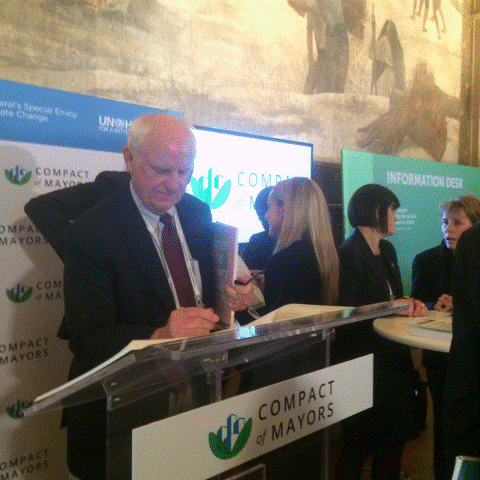
Figure 7- Signing the Compact of Mayors at UNFCC COP21 in Paris, December 2015
- 3. Equity and Quality of Life
- Conducting a Food Census and preparing a comprehensive report on access to healthy food in Richmond.
- Producing the “Mayor’s Housing Policy” report, advocating for more housing construction, and promoting housing legislation
- Raising funds and distributing youth sports grants through the Mayor’s Community Fund.
- Advocating and sponsoring legislation for annexation of North Richmond.
- Engaging in equity building through the mayor’s African American Task Force, and Government Alliance on Race & Equity
- Supporting crime prevention and community policing activities
- Assuring the successful transition of residents in Richmond’s former Hacienda housing complex
- Monitoring permitting and enforcement issues in Planning and Building to promote economic growth and neighborhood stability.
- Investigating and monitoring performance issues at the Port of Richmond.
- Supporting and promoting the Richmond Promise to create pathways to higher education
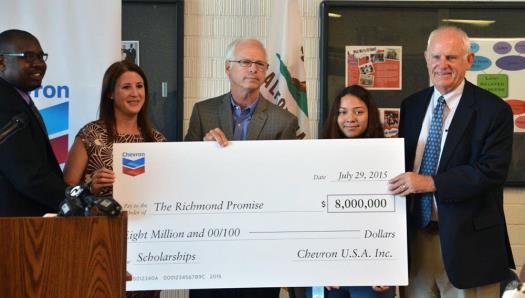
Figure 8 - The first $8 million for the Richmond Promise
In supporting my priorities as mayor and the responsibilities described in the Charter, my staff engages in a wide variety of tasks that can be broken into three general categories:
- Continuing Tasks
- Civic Leadership Tasks
- Projects
Some of these come explicitly from the Charter and are highlighted in yellow. Others have simply evolved and become customary. The category “Monitor Organizations, Agencies and Initiatives includes some that have been directed by me and others that have evolved from staff interest or advocacy. Some involve simply attending periodic meetings and monitoring issues. Others are responses to requests for assistance or policy initiatives that don’t rise to the level of projects. The list tends to change over time as interest waxes and wanes and priorities are reevaluated.
- Manage board and commission appointments
- Sign Contracts
- Mayor’s Office budget, purchases, report, Cal-Card, process reimbursement requests, etc.
- Manage proclamations, awards, recognitions, etc.
- Coordinate mayor’s participation in public events, provide background and speaking points
- Receive and respond to constituent inquiries, requests for assistance and complaints
- Participate in agenda setting
- Annual State of the City presentation
- Host Contra Costa Mayors Conference ( every 19 months)
- Letters of support to agencies and organizations
- Mayor’s Office Annual Art Selection
- Monitor Organizations, Agencies and Initiatives
- Youth Master Plan/Kids First
- RNCC
- Food Policy Council
- Cities for Action (immigration)
- Richmond Promise
- Comprehensive Economic Development Plan CDEP - (Rubicon)
- Economic Development Commission
- GARE
- Business License Enforcement
- PMCAC
- Pipeline Franchises
- Red Oak Victory
- Richmond rainbow Pride
- Cities Thrive
- Home Front/Rosie Rally
- Richmond Rainbow Pride
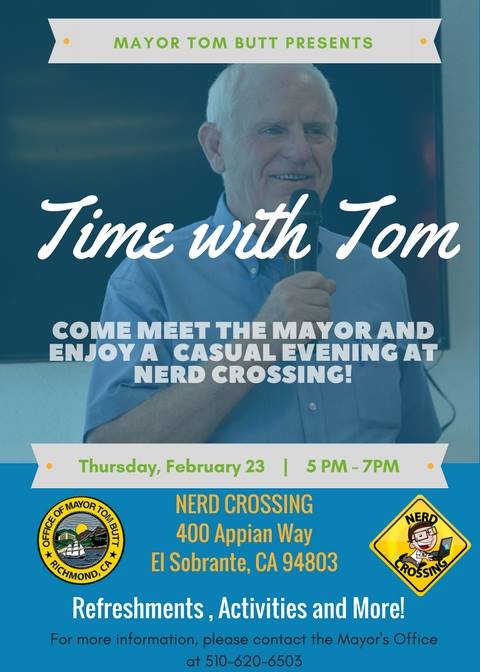
Figure 9 - Time With Tom is a quarterly meeting at a different venue each time to give people an informal opportunity to ask questions and discuss issues.
…providing civic leadership and taking issues to the people, and marshalling public interest in and support for municipal activity. The Mayor shall be concerned with the general development of the community and the general level of City services and activity programs and may develop and inform City residents of policies and programs which he or she believes are necessary for the welfare of the City.:)
Richmond does not have a designated public information officer, public relations officer or an individual or internal department designated to promote and market the City. This used to be a responsibility of the Redevelopment Agency, which had access to funding for this purpose. Today, Janet Johnson is the closest person left with an implicit marketing responsibility, and she concentrates mostly of business development and retention.
Proactive sources of positive information about the City are pretty much limited to the City Manager’s Weekly Report, which is an excellent source of information.
The mayor, however, is in a unique position to effectively communicate with the media about affairs in Richmond, to market Richmond and to boost Richmond’s image. Whether it’s good new or bad news, the mayor is the city official most often contacted by the media for comment, and we place a high priority on being accessible and responsive.
Following are the several ways that the Mayor’s Office is engaging with the media and the community to promote and market Richmond:
- Marketing and Branding (“development of the community”)
- Business Roundtable (“development of the community”)
- Social media posts and press releases (“develop and inform”)
- Testifying at the California Legislature. See https://www.facebook.com/tom.butt1944.
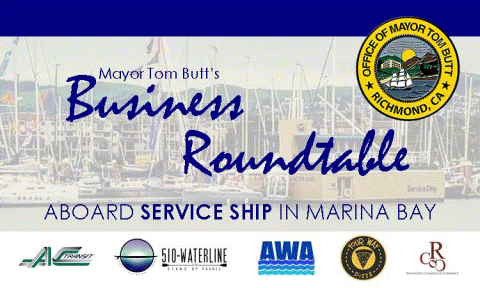

The effectiveness of the Mayor’s Office to attract media attention and build the credibility needed to be a successful spokesperson for the City has to be earned. Building that credibility is enhanced by the following:
In addition, my TOM BUTT E-FORUM is a very effective way of communicating with both the community and the media. I keep it totally separate from the Mayor’s Office in order to avoid any criticism that I am using City resources for overly political purposes.
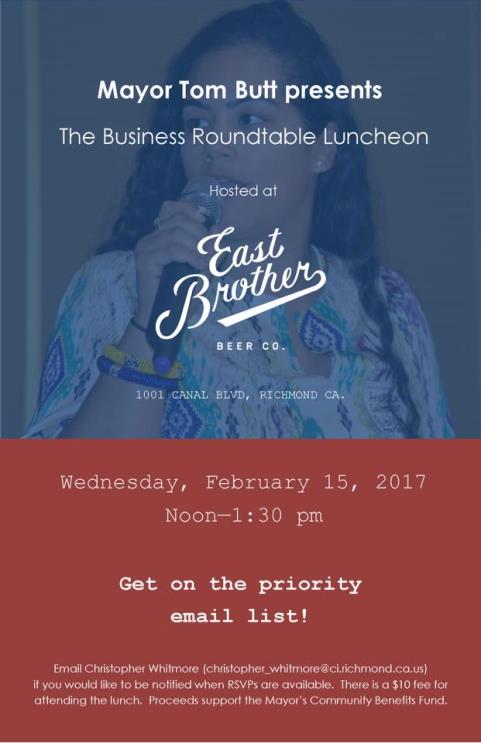
Figure 11 - Once a quarter we hold a business Roundtable to learn why new businesses have started up or relocated to Richmond
Projects are initiatives that no other department has taken a lead in, or another department has requested assistance from the Mayor’s Office. Projects typically have clear objectives or conclude with work products such as reports.
Examples include:
- Richmond Food Census
- Commercial Composting Operation Evaluation and Recommendations
- Mayor’s Housing Policy
- Urban Garden Contest
- Resource Guides
- City Resources
- Homeless Resources
- Business Startup
- Municipal Herbicide Use
- Marina Bay Wayfinding
- eQuipt to Innovate
- 2nd and Garrard acquisition
- Fundraise for 3rd of July
- Noise Ordinance
- African American Task Force
- Beacon Program
- Cities Thrive Coalition
- North Richmond Annexation
- Affordable Housing
- U.C. Berkeley Field Station (formerly Global Campus)
- Composting Issues
- Dormitory O Memorial
- Sidewalk Policy
- Mayor’s Community Fund
In addition to tasks largely carried out by staff, I continually work on issues that don’t require much staff support or don’t rise to the level of requiring staff support. My time is typically spent researching these issues, communicating with the city manager, other council members or other interested individuals. Examples include:
- Port of Richmond problems and deficiencies
- Riggers Loft and ME5 Funding shortfalls
- Noise issues at Marina Bay
- Vegetation management
- Planning and Building code enforcement
- Fats. Oil and Grease Ordinance enforcement
- Point Molate management
- Park restrooms taken over by homeless
I participate in or represent the City of Richmond in a number of regional agencies and organizations, including:
- Board member and past chair, Local Government Commission
- Commissioner, BCDC
- Alternate member, Contra Costa LAFCO
- Member, League of California Cities, Environmental Quality Policy Committee
- Member, West Contra Costa Transportation Advisory Committee (WCCTAC)
- Commissioner and chair, Contra Costa Transportation Authority
- Board Member, Richmond Representative, Vice-chair, MCE (Marin Clean Energy)
- Resilient by Design Bay Area Challenge, Executive Committee
- Association of Bay Area Governments (ABAG) Executive Committee Alternate
- West Contra Costa Mayors and Supervisors
- U/S. Conference of Mayors
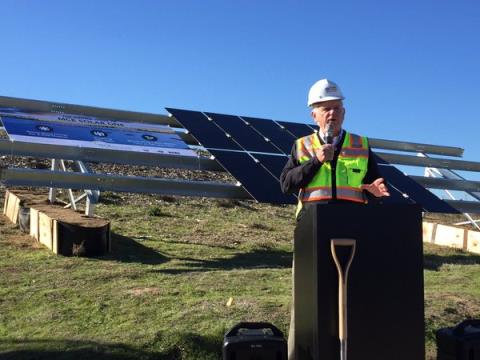
Figure 12 - Ground breaking for Solar 1 - 10.5 megawatt project in Richmond
For most of these, staff work is limited to helping with scheduling and registration, although hosting the Contra Costa Mayor’s Conference is a major staff undertaking. Each of these organizations has its own staff.

Figure 13 - The annual Urban Garden Contest highlights home food gardens to promote healthy eating
How do I spend my time? Below is a rough compilation of how my public time is typically allocated.
|
|
|
|
|
|
|
|
|
|
|
|
Recurring Monthly/Annual Events |
|
Repeats |
Time per Event(Hours, including Travel) |
Subtotal time (Hours) |
|
City Council |
|
3 |
5 |
15 |
|
Mayor Staff Meetings |
|
4 |
1.5 |
6 |
|
CCTA |
|
1 |
5 |
5 |
|
CCTA - APC |
|
1 |
4 |
4 |
|
BCDC |
|
2 |
5 |
10 |
|
MCE Board |
|
1 |
4 |
4 |
|
MCE ExCom |
|
1 |
3 |
3 |
|
WCCTAC |
|
1 |
3 |
3 |
|
West County Mayors |
|
1 |
3 |
3 |
|
CC Mayors Conference |
|
1 |
5 |
5 |
|
Chevron |
|
1 |
1 |
1 |
|
Resilient by Design |
|
1 |
2 |
2 |
|
Lunch with Bill |
|
1 |
1 |
1 |
|
LGC Board Meetings (Quarterly -prorated) |
|
0.25 |
12 |
3 |
|
LGC Annual Conference (prorated) |
|
0.083333 |
32 |
2.67 |
|
LGC Yosemite Conference (annual - prorated) |
|
0.083333 |
32 |
2.67 |
|
League of CA Cities Environmental Quality Policy Committee (quarterly prorated) |
|
0.25 |
32 |
8 |
|
ABAG General Assembly (annual - prorated) |
|
0.083333 |
4 |
0.33 |
|
|
|
|
|
|
|
Sub-Total Monthly Recurring Events Hours |
|
|
|
|
78.67 |
|
|
|
|
|
|
One-Off Events and Meetings (May 2017 as an Example) |
|
|
|
|
|
|
|
|
|
|
Miraflores Ribbon Cutting |
|
|
|
2 |
|
Marketing Branding meeting |
|
|
|
2 |
|
Zhousgan Delegation |
|
|
|
3 |
|
Meet with Gayle McLaughlin and Mike Parker |
|
|
|
1 |
|
National Police Week memorial |
|
|
|
2 |
|
Taste of Richmond |
|
|
|
2 |
|
AC Transit meeting |
|
|
|
1 |
|
Golden Gate Meats meeting |
|
|
|
1 |
|
Point Molate meeting |
|
|
|
1 |
|
Richmond Promise meeting |
|
|
|
3 |
|
North Richmond Annexation meeting |
|
|
|
1 |
|
Mayor Staff Retreat Discussion meeting |
|
|
|
2 |
|
|
|
|
|
|
|
Sub-Total One-Off Events and Meetings (May) |
Often this is more |
|
|
21 |
|
|
|
|
|
|
Miscellaneous |
|
|
|
|
|
|
|
|
|
|
|
Phone calls and emails, E-FORUMs |
|
|
|
8 |
|
Research and review |
|
|
|
16 |
|
|
|
|
|
|
|
Sub-Total Miscellaneous |
|
|
|
|
24 |
|
|
|
|
|
|
TOTAL MONTHLY MAYOR -RELATED HOURS |
|
|
|
|
123.67 |
|
|
|
|
|
|
Other Volunteer Commitments |
|
|
|
|
|
|
|
|
|
|
|
East Brother Board Meeting |
|
|
|
2 |
|
East Brother Volunteer Saturday (Wickie Day) |
|
|
|
8 |
|
Rosie the Riveter Trust Board Meetings |
|
|
|
2 |
|
Richmond Rotary |
|
|
|
8 |
|
|
|
|
|
|
|
TOTAL MONTHLY VOLUNTEER HOURS |
|
|
|
|
20 |
|
|
|
|
|
|
TOTAL HOURS |
|
|
|
|
143.67 |
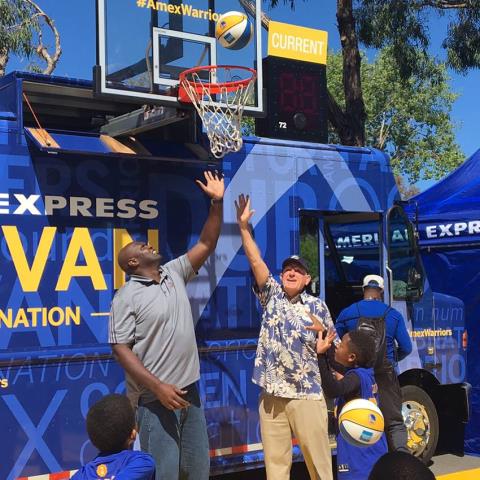
Figure 14 - Hilltop YMCA Healthy Kids Day
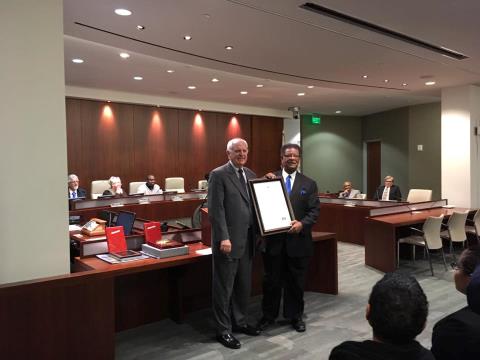
Figure 15 - Honoring Nat Bates City Council Service
Example of Mayor’s Staff Weekly Meeting Agenda
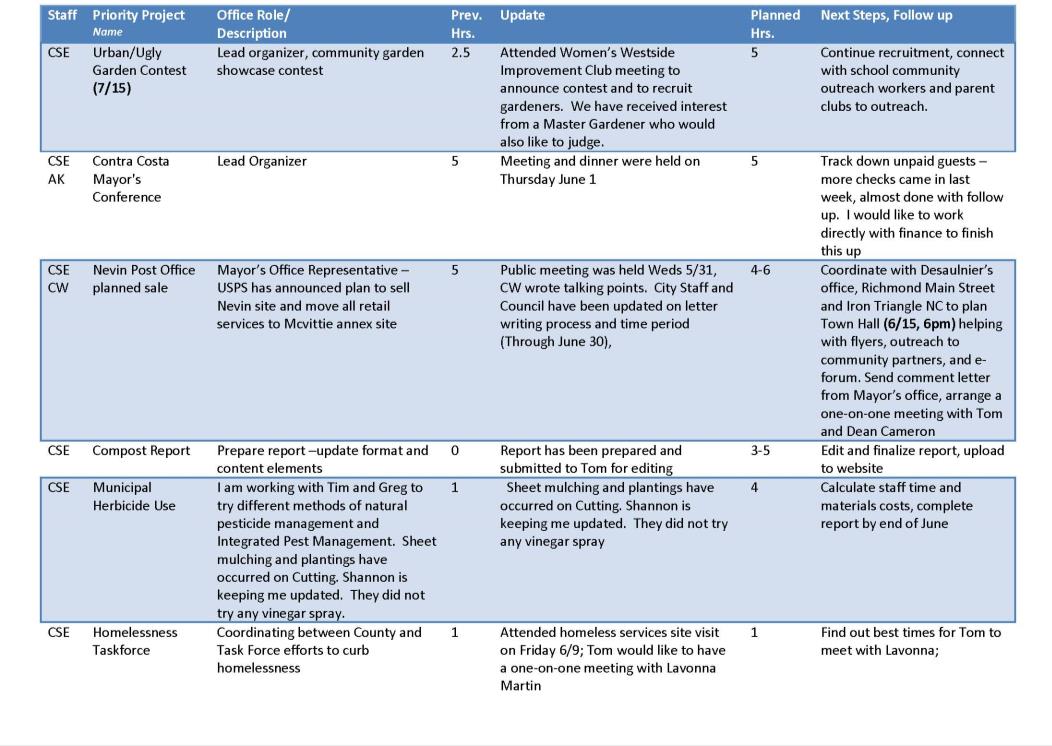
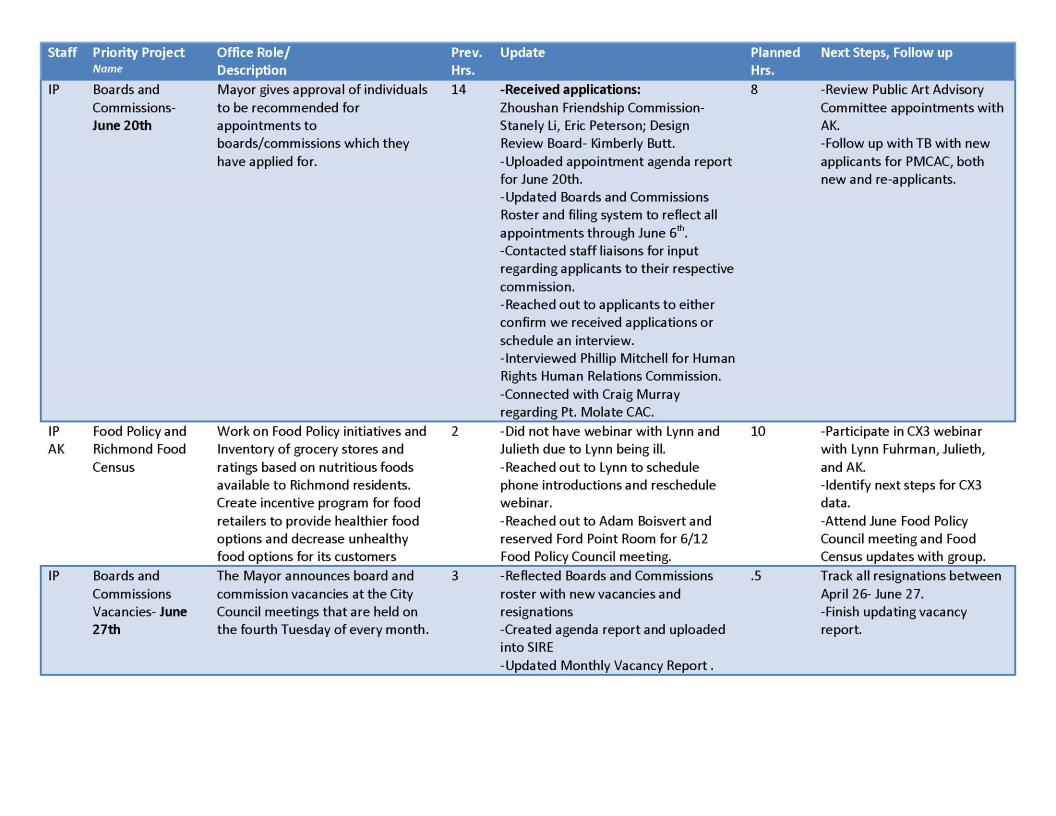
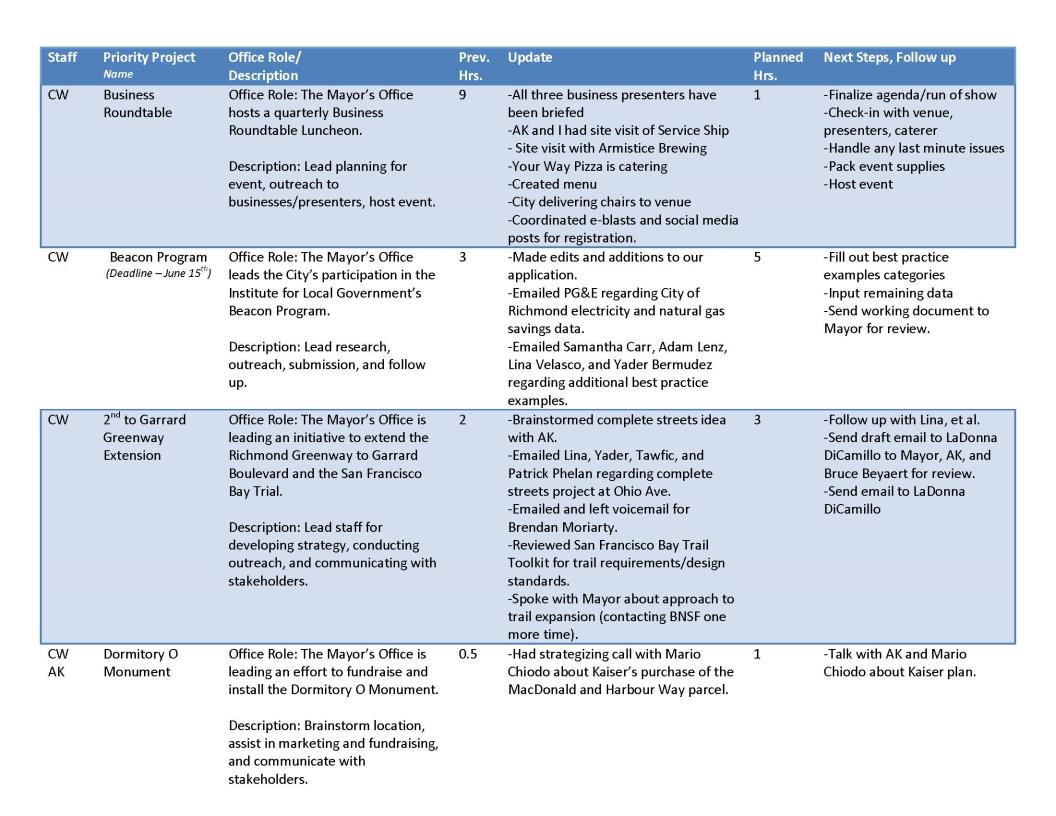
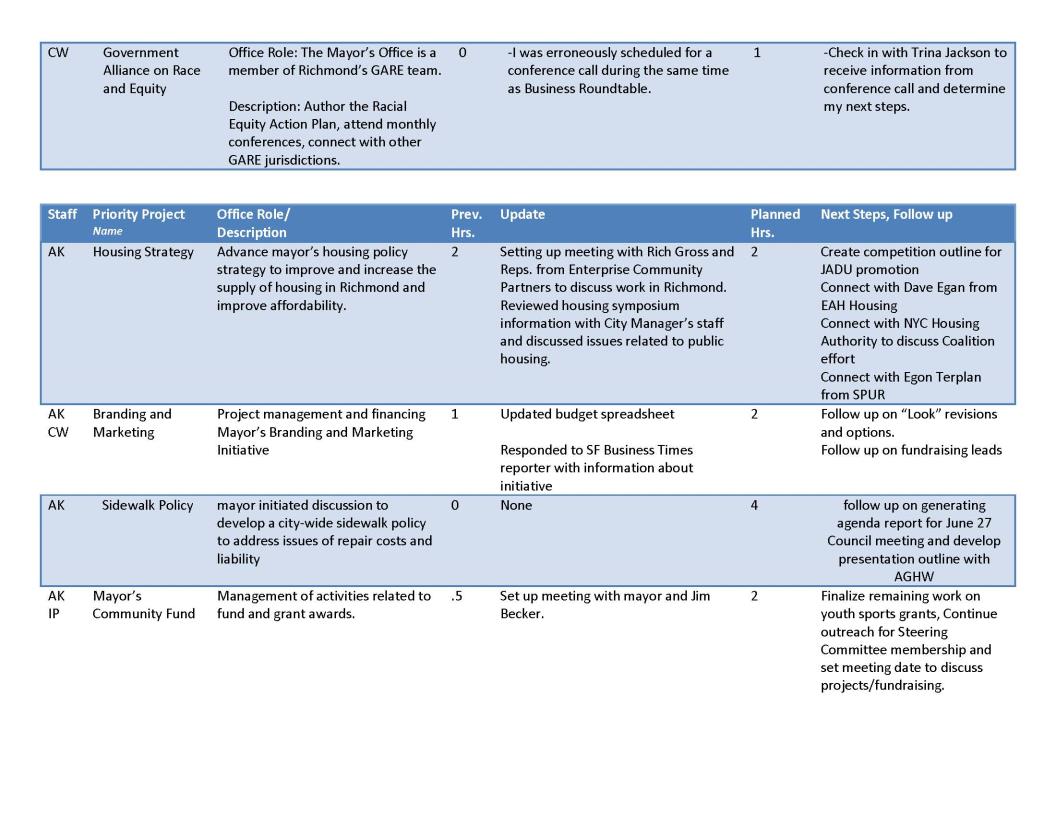
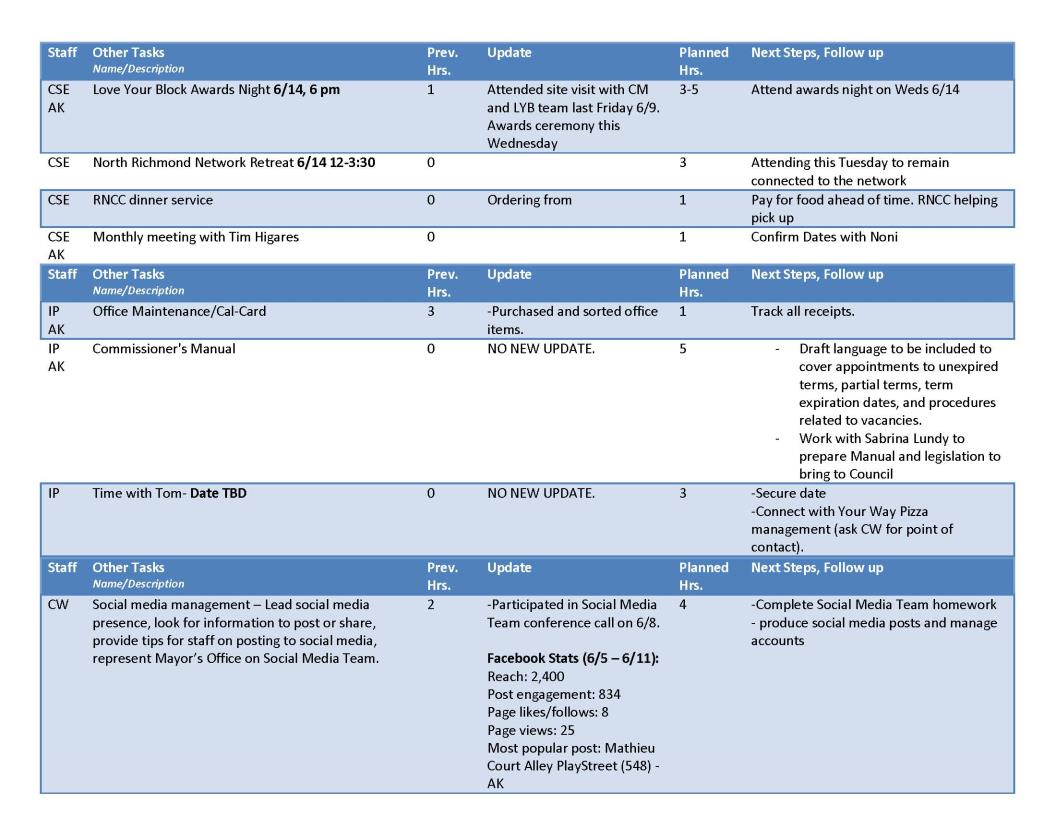
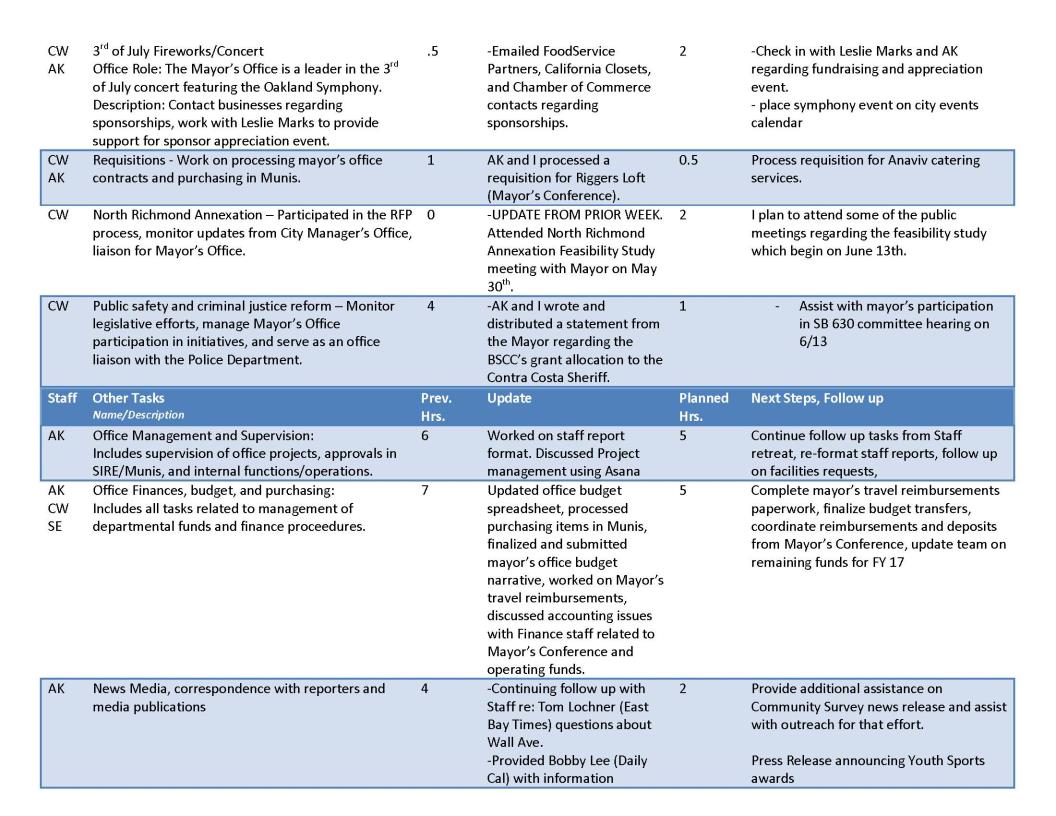 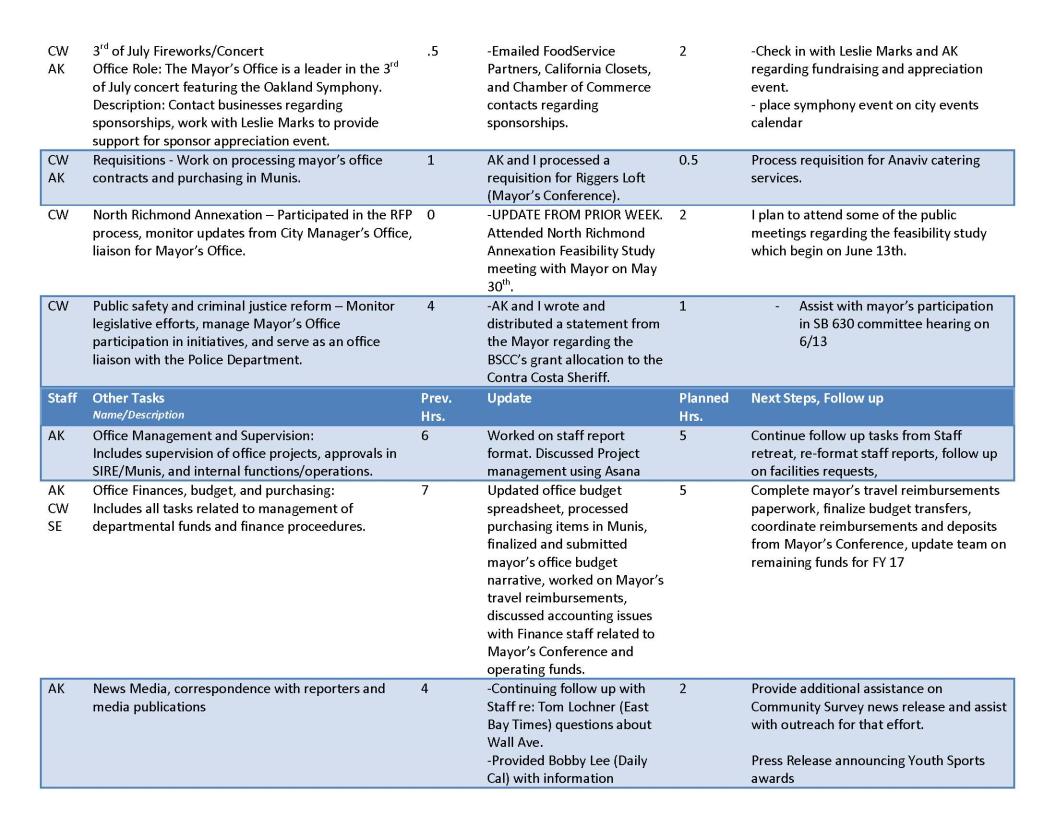 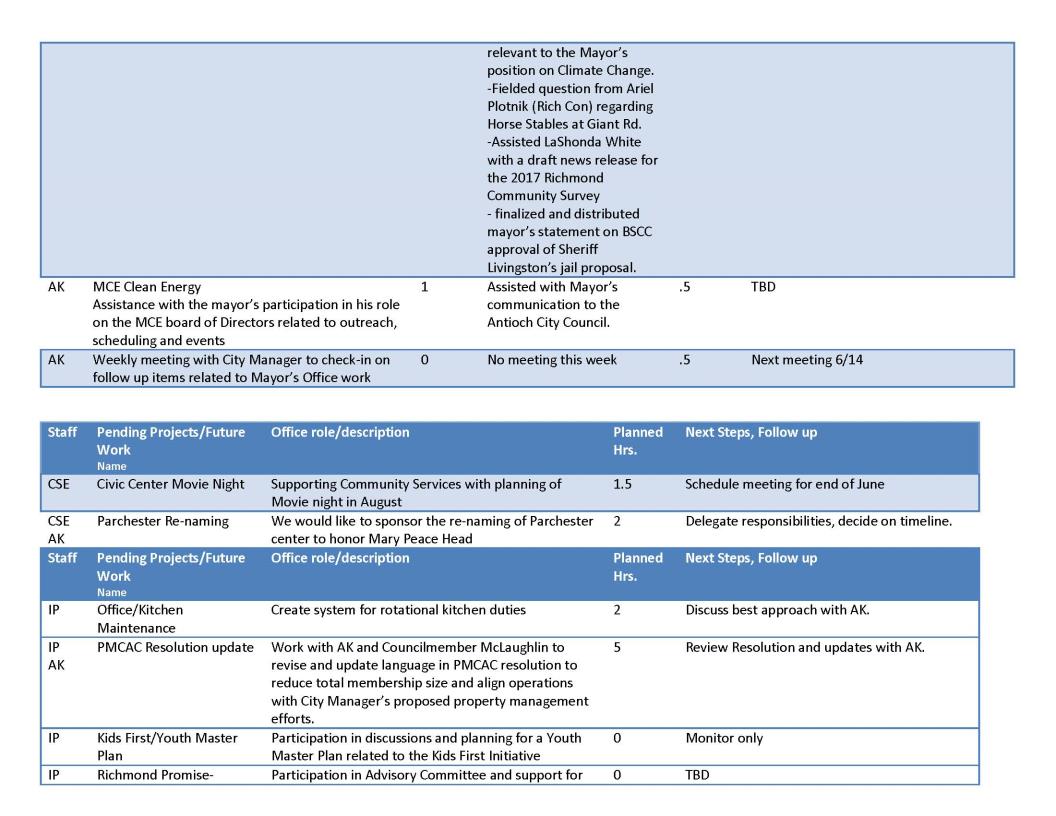 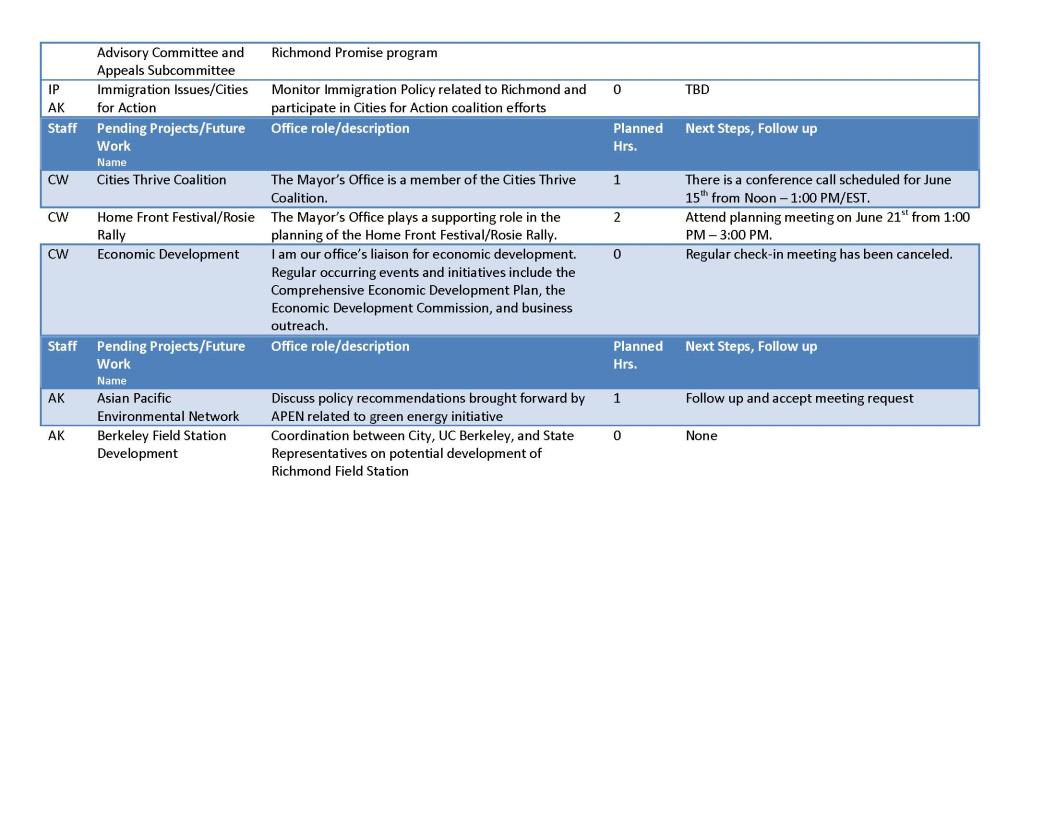 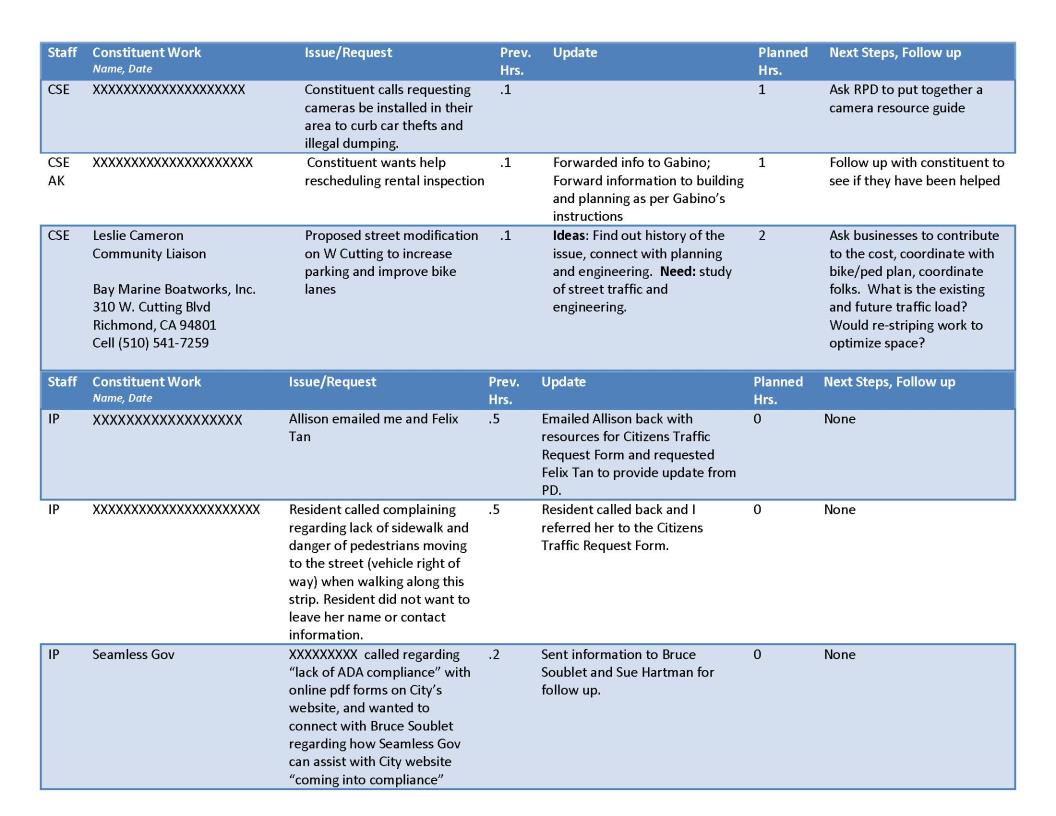 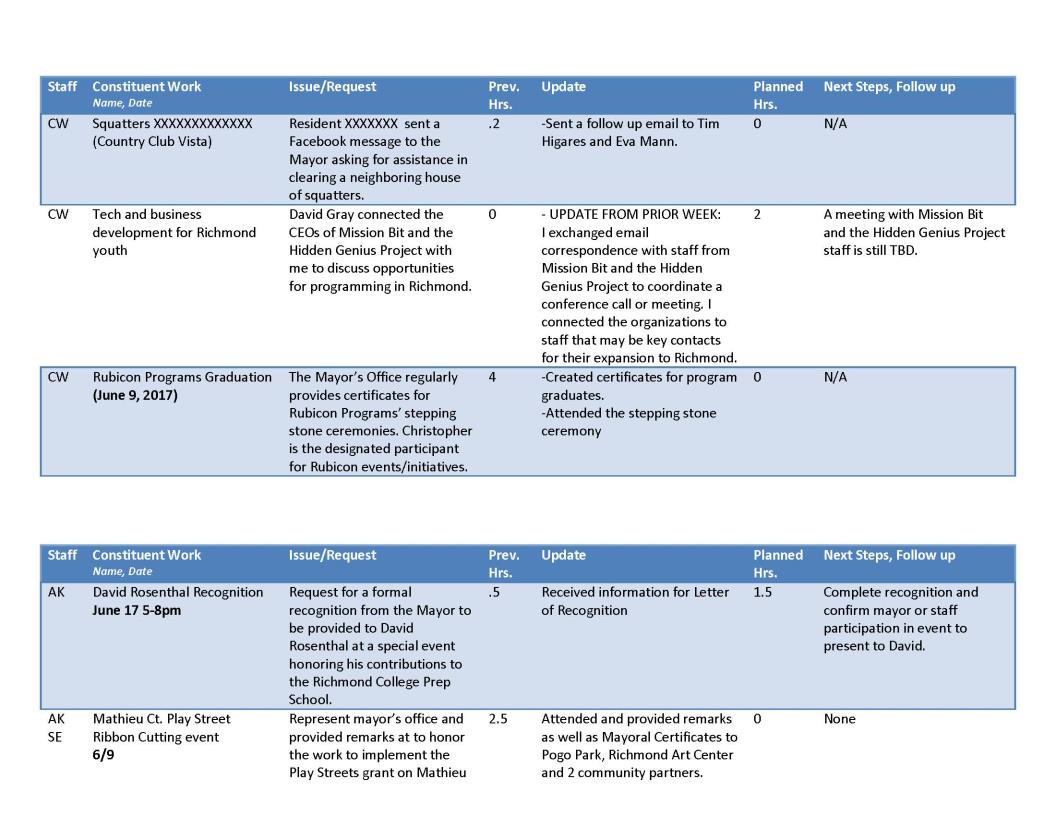 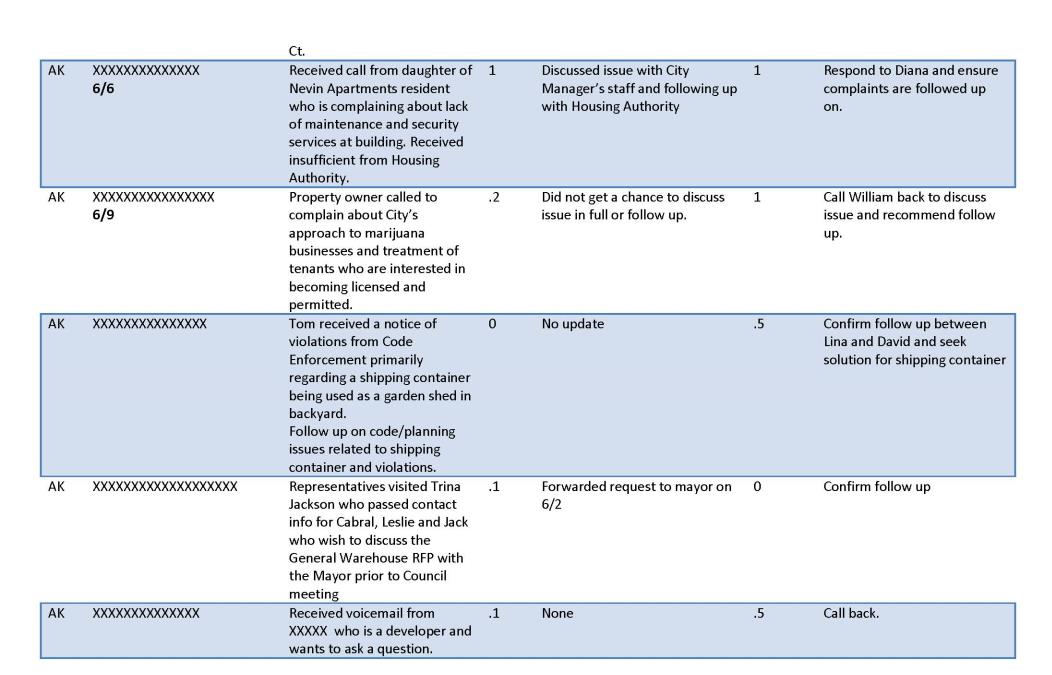
|
|

